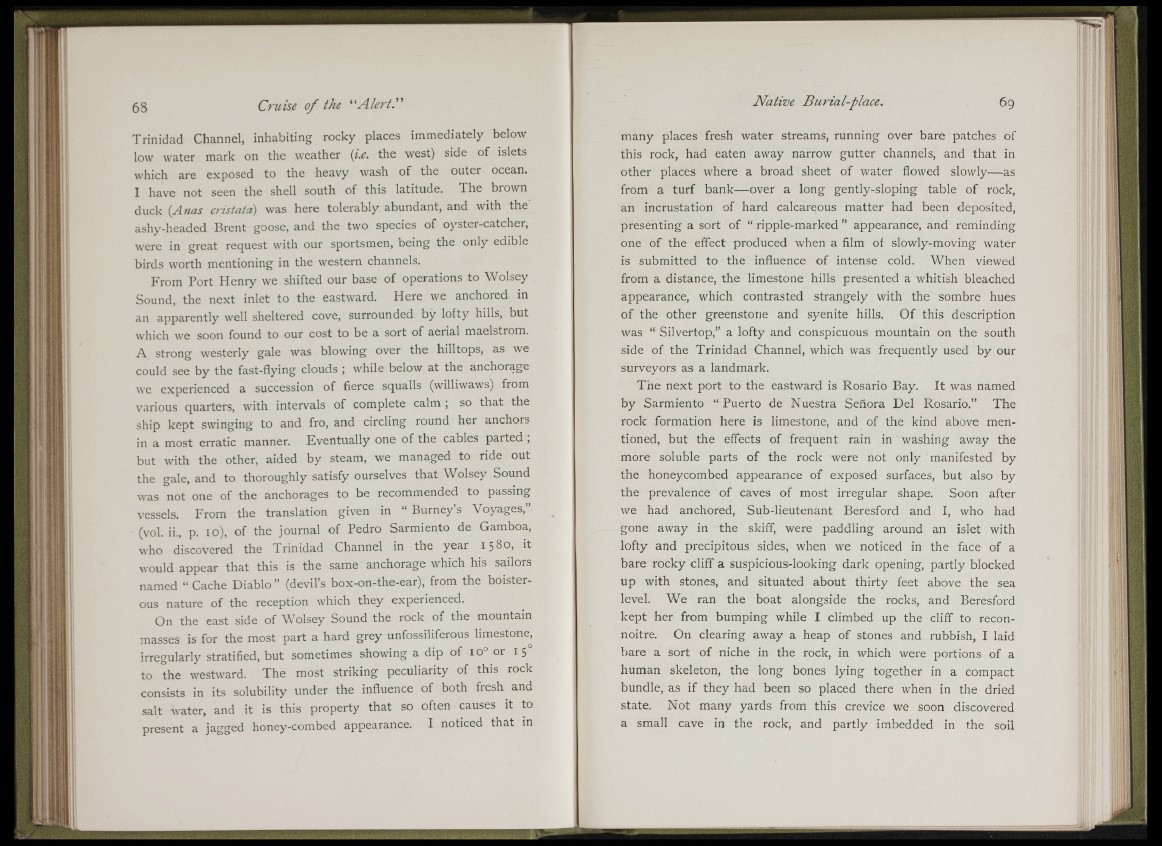
oi
Trinidad Channel, inhabiting rocky places immediately below
low water mark on the weather {i.e. the west) side of islets
which are exposed to the heavy wash of the outer ocean.
I have not seen the shell south of this latitude. The brown
duck {Anas cristata) was here tolerably abundant, and with the'
ashy-headed Brent goose, and the two species of oyster-catcher,
were in great request with our sportsmen, being the only edible
birds worth mentioning in the western channels.
From Port Flenry we shifted our base of operations to Wolsey
Sound, the next inlet to the eastward. Here we anchored in
an apparently well sheltered cove, surrounded by lofty hills, but
which we soon found to our cost to be a sort of aerial maelstrom.
A strong westerly gale was blowing over the hilltops, as we
could see by the fast-flying clouds ; while below at the anchorage
we experienced a succession of fierce squalls (williwaws) from
various quarters, with intervals of complete calm ; so that the
ship kept swinging to and fro, and circling round her anchors
in a most erratic manner. Fventually one of the cables parted ;
but with the other, aided by steam, we managed to ride out
the gale, and to thoroughly satisfy ourselves that Wolsey Sound
was not one of the anchorages to be recommended to passing
vessels. From the translation given in “ Burney’s Voyages,”
(vol. ii., p. lo), of the journal of Pedro Sarmiento de Gamboa,
who discovered the Trinidad Channel in the year 1580» it
would appear that this is the same anchorage which his sailors
named “ Cache Diablo ” (devil’s box-on-the-ear), from the boisterous
nature of the reception which they experienced.
On the east side of Wolsey Sound the rock of the mountain
masses is for the most part a hard grey unfossiliferous limestone^
irregularly stratified, but sometimes showing a dip of 10° or 15
to the westward. The most striking peculiarity of this rock
consists in its solubility under the influence of both fresh and
salt water, and it is this property that so often causes it to
present a jagged honey-combed appearance. I noticed that in
69
many places fresh water streams, running over bare patches of
this rock, had eaten away narrow gutter channels, and that in
other places where a broad sheet of water flowed slowly— as
from a turf bank— over a long gently-sloping table of rock,
an incrustation of hard calcareous matter had been deposited,
presenting a sort of “ ripple-marked ” appearance, and reminding
one of the effect produced when a film of slowly-moving water
is submitted to the influence of intense cold. When viewed
from a distance, the limestone hills presented a whitish bleached
appearance, which contrasted strangely with the sombre hues
of the other greenstone and syenite hills. Of this description
was “ Silvertop,” a lofty and conspicuous mountain on the south
side of the Trinidad Channel, which was frequently used by our
surveyors as a landmark.
The next port to the eastward is Rosario Bay. It was named
by Sarmiento “ Puerto de Nuestra Señora Del Rosario.” The
rock formation here is limestone, and of the kind above mentioned,
but the effects of frequent rain in washing away the
more soluble parts of the rock were not only manifested by
the honeycombed appearance of exposed surfaces, but also by
the prevalence of caves of most irregular shape. Soon after
we had anchored. Sub-lieutenant Beresford and I, who had
gone away in the skiff, were paddling around an islet with
lofty and precipitous sides, when we noticed in the face of a
bare rocky cliff a suspicious-looking dark opening, partly blocked
up with stones, and situated about thirty feet above the sea
level. We ran the boat alongside the rocks, and Beresford
kept her from bumping while I climbed up the cliff to reconnoitre.
On clearing away a heap of stones and rubbish, I laid
bare a sort of niche in the rock, in which were portions of a
human skeleton, the long bones lying together in a compact
bundle, as if they had been so placed there when in the dried
state. Not many yards from this crevice we soon discovered
a small cave in the rock, and partly imbedded in the soil ¡HIM iii I l
iV*